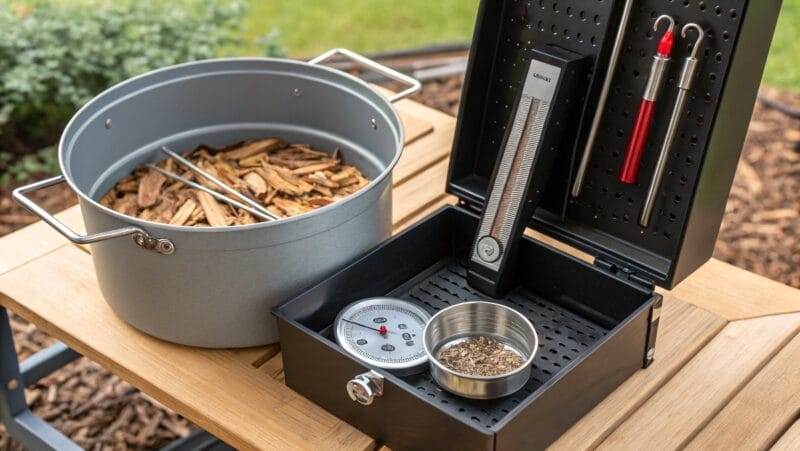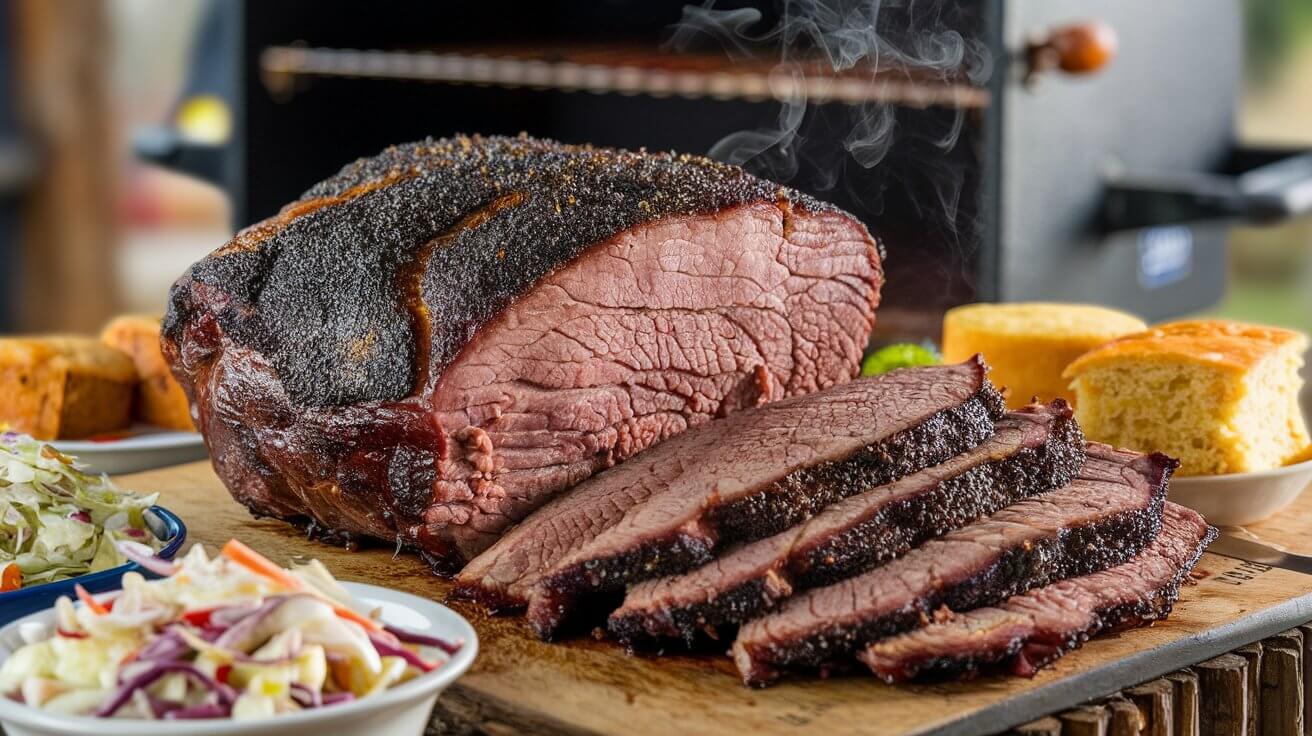Smoking meat is an age-old culinary art that brings unique and irresistible flavors to the table. For barbecue enthusiasts, it’s not just about cooking, it’s about mastering the hardest meat to smoke. While some cuts of meat are forgiving, others demand a blend of patience, precision, and perfected techniques to transform tough textures into mouthwatering results.
Table of Contents
The Intrigue of Smoking Meat
The act of smoking meat has long been cherished for its ability to elevate simple cuts into culinary masterpieces. However, it’s not without its challenges. Those who seek to become true pitmasters often find themselves intrigued by the complexities of more difficult cuts like brisket, pork belly, and ribs. These meats are unforgiving but also rewarding, requiring an understanding of how to balance temperature control, cooking time, and smoke intensity.
Tips and Tricks: Always ensure your smoker is preheated before starting and use a mix of wood types for a more complex flavor profile. The act of smoking meat has long been cherished for its ability to elevate simple cuts into culinary masterpieces. However, it’s not without its challenges. Those who seek to become true pitmasters often find themselves intrigued by the complexities of more difficult cuts like brisket, pork belly, and ribs. These meats are unforgiving but also rewarding, requiring an understanding of how to balance temperature control, cooking time, and smoke intensity.
What Makes It So Challenging?
Smoking is more than a method of cooking; it’s a science. The toughest cuts typically have dense connective tissues, uneven fat distribution, or significant size that complicates even heat and smoke penetration. To conquer these challenges, a smoker must develop expertise in essential techniques, such as low-and-slow cooking, strategic spritzing, and moisture retention methods. For instance, the perfect brisket requires hours of patience, meticulous monitoring, and advanced methods like the Texas Crutch to maintain moisture and achieve a tender finish.
Tips and Tricks: Focus on using a water pan in your smoker to maintain consistent humidity and prevent the meat from drying out. Smoking is more than a method of cooking; it’s a science. The toughest cuts typically have dense connective tissues, uneven fat distribution, or significant size that complicates even heat and smoke penetration. To conquer these challenges, a smoker must develop expertise in essential techniques, such as low-and-slow cooking, strategic spritzing, and moisture retention methods. For instance, the perfect brisket requires hours of patience, meticulous monitoring, and advanced methods like the Texas Crutch to maintain moisture and achieve a tender finish.
The Allure of Mastering Tough Cuts
For those who dare to take on these formidable meats, the payoff is unmatched. Achieving mastery over cuts like brisket or pork belly doesn’t just enhance your reputation as a pitmaster but also deepens your appreciation for the art of barbecue. It encourages experimentation with flavors, seasonings, and wood varieties to craft signature dishes that reflect your personal style. And the learning never stops; each cook is an opportunity to refine and innovate.
Tips and Tricks: Keep a smoking journal to document your methods, wood types, and outcomes for future improvement. For those who dare to take on these formidable meats, the payoff is unmatched. Achieving mastery over cuts like brisket or pork belly doesn’t just enhance your reputation as a pitmaster but also deepens your appreciation for the art of barbecue. It encourages experimentation with flavors, seasonings, and wood varieties to craft signature dishes that reflect your personal style. And the learning never stops; each cook is an opportunity to refine and innovate.
Achieving mastery over cuts like brisket or pork belly doesn’t just enhance your reputation as a pitmaster but also expands your range to other recipes like this Smoked Meatloaf Recipe.
Why Should You Care About the Hardest Meat to Smoke?
For many, the challenge itself is the draw. Smoking difficult cuts is an exercise in resilience and attention to detail. It’s about transforming seemingly unyielding meats into tender, flavorful delights that wow family, friends, or competition judges. Mastering these challenges equips you with the confidence to tackle any meat, ensuring consistent, impressive results.
Tips and Tricks: Begin with smaller cuts to practice and gradually move to larger, more challenging ones like brisket or turkey. For many, the challenge itself is the draw. Smoking difficult cuts is an exercise in resilience and attention to detail. It’s about transforming seemingly unyielding meats into tender, flavorful delights that wow family, friends, or competition judges. Mastering these challenges equips you with the confidence to tackle any meat, ensuring consistent, impressive results.
So, what exactly is the hardest meat to smoke, and how do you succeed? Let’s dive into the intricacies and strategies that will empower you to conquer the most demanding cuts and emerge as a true pitmaster.
Understanding the Challenges of Smoking Hardest Meat to Smoke

Smoking meat involves slow cooking over low heat with the addition of wood smoke to infuse flavor. While the process may seem straightforward, certain factors make some meats particularly tricky to handle.
Factors That Make Smoking Meat Challenging
- Texture and Toughness: Cuts high in connective tissue or low in fat content can be harder to tenderize.
- Fat Content and Marbling: Meats with too much fat can become greasy, while lean cuts risk drying out.
- Size and Uniformity: Larger cuts or unevenly shaped pieces can cook unevenly, leading to underdone or overdone sections.
Understanding these factors is crucial for anyone attempting to smoke tougher meats. Check out this guide on meat smoking basics for foundational knowledge.
Science Behind Smoking Tough Meats

The key to tenderizing tough meats lies in breaking down collagen and rendering fat. Collagen, a connective tissue, transforms into gelatin when cooked slowly at low temperatures. This process not only tenderizes the meat but also locks in moisture, resulting in juicy, flavorful dishes.
Tips and Tricks: Let the meat rest after smoking to allow juices to redistribute, enhancing tenderness and flavor.
The key to tenderizing tough meats lies in breaking down collagen and rendering fat. Collagen, a connective tissue, transforms into gelatin when cooked slowly at low temperatures. This process not only tenderizes the meat but also locks in moisture, resulting in juicy, flavorful dishes.
The Hardest Meats to Smoke (Ranked and Explained)
When it comes to challenging meats, a few cuts stand out for their difficulty. Here’s why they’re tough and how you can master them.
1. Brisket, The King of Tough Meats
Why It’s Challenging:
- Brisket is notorious for its long cook times, often requiring 12-18 hours to smoke properly.
- Its composition, a tough cut with significant connective tissue, demands precision to avoid drying out.
Tips for Success:
- Cook low and slow to allow the collagen to break down gradually.
- Use the “Texas Crutch” method: wrapping the brisket in foil or butcher paper midway through smoking to retain moisture.
- Maintain a consistent smoker temperature, ideally between 225-250°F.
Maintaining moisture is key to achieving tender results. Discover more techniques in our guide on how to prevent dry smoked meat
2. Pork Belly
Why It’s Challenging:
- The high-fat content makes it prone to becoming overly greasy.
- Achieving a balance between crispy skin and juicy meat is an art.
Tips for Success:
- Render the fat slowly to achieve tenderness without greasiness.
- Opt for a two-phase cook: start at a lower temperature to tenderize, then finish with a higher temperature for crispiness.
3. Beef Ribs, Flavorful but Tricky
Why It’s Challenging:
- Larger ribs can cook unevenly due to their size and varying thickness.
- Maintaining moisture while achieving a smoky crust can be tricky.
Tips for Success:
- Spritz the ribs with a mixture of apple cider vinegar and water throughout the cook. Learn more about spritzing techniques to maintain moisture.
- Use a meat thermometer to ensure the internal temperature reaches at least 203°F for optimal tenderness.
4. Whole Turkey, A Lean Challenge
Why It’s Challenging:
- The varying thickness of a turkey means the breast can dry out before the legs are cooked.
- Even smoke distribution is harder with such a large bird.
Struggling with turkey dryness? Check out this Herb-Roasted Turkey Recipe for more tips
Tips for Success:
- Brine the turkey overnight to retain moisture and enhance flavor.
- Spatchcock (butterfly) the turkey to even out cooking times.
- Use a combination of indirect heat and frequent temperature monitoring.
| Meat | Difficulty | Key Challenges | Pro Tip |
| Brisket | Very Hard | Tough cut, dries out easily | Maintain steady low temperature (225°F) |
| Beef Ribs | Hard | Thick bones, uneven cooking | Use a water pan to control moisture |
| Turkey | Medium | Lean meat, prone to dryness | Brine before smoking for 12–24 hours |
| Pork Shoulder | Easy to Medium | Fatty but forgiving | Wrap in foil (“Texas Crutch”) after stall |
Key Techniques for Smoking Hardest Meat to Smoke

1. Low-and-Slow Cooking
Low temperatures allow for gradual collagen breakdown, preventing tough textures. Aim for 225-250°F and use wood like oak or hickory for optimal flavor.
2. Brining and Seasoning
Brining adds moisture and infuses the meat with flavor. Explore our brining guide for detailed techniques. Dry rubs complement brining by creating a flavorful crust. Experiment with combinations of salt, sugar, and spices.
Experiment with diverse seasoning methods, such as this Ultimate Mexican Chicken Marinade for Grilling, to craft unique flavor profiles
Try blending flavors with creative rubs, like this Prime Rib Seasoning, to elevate your barbecue game, and Explore a variety of dry rubs to suit your taste, such as this Meatloaf Seasoning.
3. Tools and Techniques
- Use a reliable smoker thermometer for precise temperature control.
- Incorporate water pans in your smoker to maintain humidity.
- Employ wrapping techniques like the Texas Crutch for tougher cuts.
Common Mistakes and How to Avoid Them About Hardest Meat to Smoke
Overcooking or Undercooking
- Solution: Monitor temperatures consistently using a meat thermometer.
Skipping Resting Times
- Allow meat to rest after cooking to redistribute juices evenly.
Using Inappropriate Wood Types
- Avoid overly intense woods like mesquite for delicate cuts. Opt for mild woods like apple or cherry for a balanced flavor profile.
FAQs About Hardest Meat to Smoke
When it comes to smoking challenging meats, many questions arise for both novices and seasoned barbecue enthusiasts. These FAQs aim to address common concerns and provide actionable solutions to help you succeed in your smoking endeavors.
Which Meat is the Hardest to Smoke and Why?
Arguably, brisket is the hardest meat to smoke due to its unique composition and the level of precision required to perfect it. A brisket’s toughness stems from its high content of connective tissue, which requires prolonged low-temperature cooking to break down into tender gelatin. The long cooking time, often spanning 12 to 18 hours, also presents a challenge, as it demands constant monitoring of both the smoker’s temperature and the meat’s internal temperature. Additionally, achieving the perfect balance between a flavorful crust (bark) and a juicy interior makes brisket the ultimate test of a pitmaster’s skills.
How Can I Make Smoking Brisket Easier?
Mastering brisket can seem daunting, but employing specific techniques can make the process more manageable:
- Brining: This step helps lock in moisture and adds flavor, creating a safety net against drying out the meat.
- The Texas Crutch: Wrapping the brisket in foil or butcher paper midway through cooking can help retain moisture and speed up the cooking process.
- Precise Temperature Monitoring: Use a high-quality meat thermometer to ensure the internal temperature reaches the desired range of 195-203°F, where the collagen has fully broken down into gelatin.
- Consistent Heat: Avoid temperature fluctuations by regularly checking the fuel source and smoker vents. For beginners, using a pellet smoker can provide consistent heat with minimal effort.
Do Lean Meats Require Different Smoking Techniques?
Yes, lean meats such as turkey or pork loin require distinct approaches due to their lower fat content. Without sufficient fat to keep the meat moist during smoking, lean cuts are more susceptible to drying out. Key techniques include:
- Brining: A salt-based brine hydrates the meat and adds flavor, compensating for the lack of natural fat.
- Lower Smoke Intensities: Use milder woods like apple or cherry to avoid overpowering the delicate flavors of lean meats.
- Moisture Maintenance: Regular spritzing with a liquid such as apple cider vinegar or a diluted juice blend can help keep the surface moist and improve smoke absorption.
What’s the Best Way to Recover Over-Smoked Meat?
Over-smoking or drying out meat doesn’t have to result in disaster. Here are some strategies to salvage your hard work:
- Rehydrating: Wrap the over-smoked meat in aluminum foil with a liquid like broth, apple juice, or even beer. Place it back in a low-temperature smoker or oven (around 225°F) for 30-60 minutes to allow the liquid to rehydrate the meat.
- Shredding: For meats like brisket or pork shoulder, shredding the meat and mixing it with a flavorful barbecue sauce can mask dryness and restore moisture.
- Creative Repurposing: Use the meat in soups, stews, or tacos where added moisture from other ingredients can counteract any dryness.
What is the Ideal Smoker for Beginners?
Selecting the right smoker can significantly impact your smoking experience, especially when tackling challenging meats. Check out this smoker guide for beginners to make an informed choice. For beginners, pellet smokers are highly recommended due to their ease of use and ability to maintain consistent temperatures with minimal supervision. Alternatively, electric smokers are another beginner-friendly option, offering precise temperature control without the need for managing wood or charcoal.
By addressing these frequently asked questions, you’ll be better prepared to tackle even the most challenging cuts with confidence. Remember, each attempt is an opportunity to learn and improve, making the journey as rewarding as the results.
Mastering the Art of Smoking Meat: Turning Tough Cuts into Culinary Triumphs
Smoking meat is more than just cooking, it’s a journey of discovery and mastery. Working with tougher cuts like brisket or pork belly presents exciting challenges that push you to refine your skills in low-and-slow cooking. Each cook becomes an opportunity to perfect the art of brining, hone your temperature control techniques, and unlock the full potential of every cut.
As you delve deeper into smoking, you’ll develop a natural sense for timing, flavor pairing, and preparation that transforms even the toughest cuts into melt-in-your-mouth delights. It’s a process that invites you to experiment boldly, embrace the lessons in every attempt, and relish the satisfaction of creating something truly special.
Let your passion for barbecue inspire you to become a true artisan, crafting meals that bring people together and leave lasting memories. Smoking meat isn’t just about the food, it’s about the joy of the journey and the pride in every flavorful triumph.

